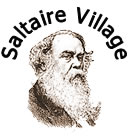|
Albert Terrace, Saltaire
Introduction | Ada St | Albert Rd | Albert Terrace | Alexandra Square | Amelia St | Caroline St | Constance St | Daisy Place | Dove St | Edward St | Exhibition Rd | Fanny St | Fern Place | George St | Gordon Terr | Harold Place | Helen St | Herbert St | Higher School St | Jane St | Katherine St | Lockwood St | Lower School St | Mary St | Mawson St | Myrtle Place | Shirley St | Titus St | Victoria Rd | Victoria Terr | Whitlam St | William Henry St
< Previous | Next >
Albert Terrace was named after Queen Victoria’s husband, Prince Albert.
Albert (1819-1861) was the younger son of Ernst, Duke of Saxe-Coburg and Gotha. Born at Schloss Rosenau, he was educated in Brussels and Bonn, and in 1839 was introduced to the young Queen Victoria (his cousin) in a visit to London. The couple subsequently married, in February 1840.
Prince Albert took an active interest in the arts, science, trade and industry, doing so at a time when Britain’s imperial power was in the ascendancy. The venture for which he is best remembered was the Great Exhibition of 1851.
To fully appreciate the marking of respect for the Royal family, it is worth understanding the close links that Saltaire’s founder had with Albert’s brainchild, the Great Exhibition. At this time Titus Salt, as well as operating his several mills in Bradford and having embarked on the construction of Salts Mill, was also heavily involved in exhibiting his products at the Great Exhibition. With the latter’s closure at the end of 1851, its glass buildings were put up for sale, and Salt even considered purchasing part of the structure as a weaving shed, but inspection found it unsuitable.
The Terrace, built 1854-61, consists of properties originally established as lodging houses – an early requirement in the developing township.
© Barlo & Shaw
|

